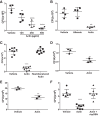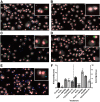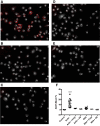Free actin impairs macrophage bacterial defenses via scavenger receptor MARCO interaction with reversal by plasma gelsolin
- PMID: 28385809
- PMCID: PMC5495953
- DOI: 10.1152/ajplung.00067.2017
Free actin impairs macrophage bacterial defenses via scavenger receptor MARCO interaction with reversal by plasma gelsolin
Abstract
Lung injury can release intracellular actin into the alveolar milieu and is also associated with increased susceptibility to secondary infections. We investigated the effect of free (extracellular) actin on lung macrophage host defense functions. Western blot analysis demonstrated free actin release into the lung lavage fluids of mouse models of ozone injury, influenza infection, and secondary pneumococcal pneumonia and in samples from patients following burn and inhalation injury. Using levels comparable with those observed in lung injury, we found that free actin markedly inhibited murine lung macrophage binding and uptake in vitro of S. pneumoniae, S. aureus, and E. coli, (e.g., S. pneumoniae, mean %inhibition, actin vs. vehicle: 85 ± 0.3 (SD); n = 22, P < .001). Similar effects were observed on the ability of primary human macrophages to bind and ingest fluorescent Saureus (~75% inhibition). Plasma gelsolin (pGSN), a protein that functions to bind and cleave actin, restored bacterial binding and uptake by both murine and human macrophages. Scavenger receptor inhibitors reduced binding of fluorescent actin by murine macrophages [fluorescence index (×10-3) after incubation with vehicle, actin, or actin + polyinosinic acid, respectively: 0.8 ± 0.7, 101.7 ± 50.7, or 52.7 ± 16.9; n = 5-6, P < 0.05]. In addition, actin binding was reduced in a MARCO/SR-AI/II-deficient cell line and by normal AMs obtained from MARCO-/- mice. After release from injured cells during lung injury, free actin likely contributes to impaired host defense by blocking scavenger receptor binding of bacteria. This mechanism for increased risk of secondary infections after lung injury or inflammation may represent another target for therapeutic intervention with pGSN.
Keywords: actin; alveolar macrophages; plasma gelsolin; scavenger receptors.
Copyright © 2017 the American Physiological Society.
Figures






Similar articles
-
Plasma gelsolin improves lung host defense against pneumonia by enhancing macrophage NOS3 function.Am J Physiol Lung Cell Mol Physiol. 2015 Jul 1;309(1):L11-6. doi: 10.1152/ajplung.00094.2015. Epub 2015 May 8. Am J Physiol Lung Cell Mol Physiol. 2015. PMID: 25957291 Free PMC article.
-
The scavenger receptor MARCO is required for lung defense against pneumococcal pneumonia and inhaled particles.J Exp Med. 2004 Jul 19;200(2):267-72. doi: 10.1084/jem.20040731. J Exp Med. 2004. PMID: 15263032 Free PMC article.
-
Role of the scavenger receptor MARCO in alveolar macrophage binding of unopsonized environmental particles.J Exp Med. 1999 May 3;189(9):1497-506. doi: 10.1084/jem.189.9.1497. J Exp Med. 1999. PMID: 10224290 Free PMC article.
-
Role of scavenger receptor a family in lung inflammation from exposure to environmental particles.J Immunotoxicol. 2008 Apr;5(2):151-7. doi: 10.1080/15476910802085863. J Immunotoxicol. 2008. PMID: 18569385 Review.
-
Plasma gelsolin: function, prognostic value, and potential therapeutic use.Curr Protein Pept Sci. 2008 Dec;9(6):541-51. doi: 10.2174/138920308786733912. Curr Protein Pept Sci. 2008. PMID: 19075745 Review.
Cited by
-
Low Admission Plasma Gelsolin Concentrations Identify Community-acquired Pneumonia Patients at High Risk for Severe Outcomes.Clin Infect Dis. 2019 Sep 13;69(7):1218-1225. doi: 10.1093/cid/ciy1049. Clin Infect Dis. 2019. PMID: 30561561 Free PMC article.
-
Selective Uptake of Carboxylated Multi-Walled Carbon Nanotubes by Class A Type 1 Scavenger Receptors and Impaired Phagocytosis in Alveolar Macrophages.Nanomaterials (Basel). 2020 Dec 3;10(12):2417. doi: 10.3390/nano10122417. Nanomaterials (Basel). 2020. PMID: 33287183 Free PMC article.
-
Recombinant Human Plasma Gelsolin Improves Survival and Attenuates Lung Injury in a Murine Model of Multidrug-Resistant Pseudomonas aeruginosa Pneumonia.Open Forum Infect Dis. 2020 Jun 19;7(8):ofaa236. doi: 10.1093/ofid/ofaa236. eCollection 2020 Aug. Open Forum Infect Dis. 2020. PMID: 32766380 Free PMC article.
-
Plasma Gelsolin: Indicator of Inflammation and Its Potential as a Diagnostic Tool and Therapeutic Target.Int J Mol Sci. 2018 Aug 25;19(9):2516. doi: 10.3390/ijms19092516. Int J Mol Sci. 2018. PMID: 30149613 Free PMC article. Review.
-
Recombinant human plasma gelsolin (rhu-pGSN) in a patient hospitalized with critical COVID-19 pneumonia.Clin Infect Pract. 2021 Nov;12:100088. doi: 10.1016/j.clinpr.2021.100088. Epub 2021 Aug 10. Clin Infect Pract. 2021. PMID: 34396087 Free PMC article.
References
-
- Al Ashry HS, Mansour G, Kalil AC, Walters RW, Vivekanandan R. Incidence of ventilator associated pneumonia in burn patients with inhalation injury treated with high frequency percussive ventilation versus volume control ventilation: A systematic review. Burns 42: 1193–1200, 2016. doi: 10.1016/j.burns.2016.02.024. - DOI - PubMed
-
- Chang DW, Hayashi S, Gharib SA, Vaisar T, King ST, Tsuchiya M, Ruzinski JT, Park DR, Matute-Bello G, Wurfel MM, Bumgarner R, Heinecke JW, Martin TR. Proteomic and computational analysis of bronchoalveolar proteins during the course of the acute respiratory distress syndrome. Am J Respir Crit Care Med 178: 701–709, 2008. doi: 10.1164/rccm.200712-1895OC. - DOI - PMC - PubMed
Publication types
MeSH terms
Substances
Grants and funding
LinkOut - more resources
Full Text Sources
Other Literature Sources
Molecular Biology Databases
Research Materials
Miscellaneous

